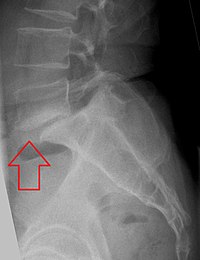
Photo from wikipedia
Study Design: This was a retrospective cohort study. Objective: The objective of this study was to compare radiographic and patient-reported outcome measures (PROMs) between circumferential fusions and transforaminal lumbar interbody… Click to show full abstract
Study Design: This was a retrospective cohort study. Objective: The objective of this study was to compare radiographic and patient-reported outcome measures (PROMs) between circumferential fusions and transforaminal lumbar interbody fusion (TLIF) for adult isthmic spondylolisthesis (IS). Summary of Background Data: Definitive management of adult IS typically requires decompression and fusion. Multiple fusion techniques have been described, but literature is sparse in identifying the optimal technique. Methods: Patients with IS undergoing single-level or 2-level circumferential fusion or TLIF with a minimum 1-year follow-up were included. Patient demographics, surgical characteristics, and PROMs were extracted from patients’ electronic medical records. Descriptive statistics and multivariate regression analysis compared outcomes with significance set at P-value <0.05. Results: A total of 78 circumferential fusions (48 open decompression and fusions and 30 circumferential fusions utilizing posterior percutaneous instrumentation) and 50 TLIF procedures were included. Length of stay was significantly longer when comparing circumferential procedures (3.56±0.96 d) versus TLIFs (2.88±1.14 d) (P=0.002). The circumferential fusion group resulted in greater postoperative improvement in segmental lordosis [anterior/posterior (A/P): 6.45, TLIF: −1.99, P<0.001], posterior disk height (A/P: 12.6 mm, TLIF: 8.9 mm, P<0.001), and ∆disk height (A/P: 7.7 mm, TLIF: 3.6 mm, P<0.001). Both groups significantly improved in all PROMs (P<0.001). While the circumferential fusion group had a significantly higher rate of perioperative surgical complications (12.82% vs. 2.00%, P=0.049), there was no difference in the rate of 30-day readmissions (P=0.520) or revision surgeries between techniques (P=0.057). Conclusions: Circumferential fusions are associated with improvements in radiographic outcomes compared with TLIFs, but this is at the expense of longer hospital length of stay and increased risk for perioperative complications. The surgical technique did not result in superior postoperative PROMs or differences in readmissions or revisions.
Journal Title: Clinical Spine Surgery
Year Published: 2022
Link to full text (if available)
Share on Social Media: Sign Up to like & get
recommendations!